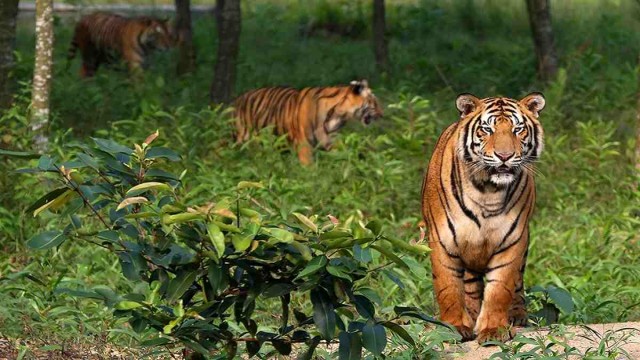Sundarbans is the largest mangrove forest in the world. Sundarbans is unparalleled in natural beauty and extraordinary in biodiversity. It is an attractive place not only to the people of Bangladesh but also to the nature lovers of the world.
Next February 14 is Sundarban Day. For the past few years, this day has been celebrated as the beautiful forest day in several districts of Sundarban including Khulna Bagerhat Satkhira. Various plans are taken to protect this largest forest in the world. Then day by day Sundarbans is losing its charm.
The Sundarbans is a vast forest located along the Bay of Bengal and is one of the natural wonders of the world. Located in the delta region of the Padma, Meghna and Brahmaputra river basins, this magnificent forest covers parts of Khulna, Satkhira and Bagerhat districts of Bangladesh and the two districts of North Twenty-four Parganas and South Twenty-four Parganas of the Indian state of West Bengal. The largest of the coastal saline environments. As mangrove forests The Sundarbans are the largest intact forest in the world. Spread over 10,000 square kilometers, 6,517 square kilometers (66%) of the Sundarbans lie in Bangladesh and the rest (34%) in India.
The soil of Sundarbans is slightly different than that of the interior of Bangladesh. Due to tides, the water here is waterlogged and salinity is high. The soil here is silty loam.Most of the vegetation of Sundarbans is mangrove type. There are plants such as trees, vines, grasses, ferns etc. 35 of the 50 mangrove species found in the world are found in the Sundarbans. Sundarbans plants include Sundari, Garan, Gewa, Keora, Pasur, Dhundal, Bain etc. Golpata grows almost everywhere in this forest.
The Sundarbans were recognized as a UNESCO World Heritage Site on 6 December 1997. Although the Bangladeshi and Indian parts of the Sundarbans are actually contiguous parts of the same unbroken landmass, they are listed under different names on the UNESCO World Heritage List; Named as 'Sunderban' and 'Sunderban National Park' respectively. Despite this protection, the Indian Sundarbans were considered endangered in the 2020 assessment under the IUCN Red List of Ecosystem Framework. The Sundarbans are a web of small islands with ocean currents, mudflats and salinity of mangrove forests. 31.1 percent of the total forest area, i.e. 1,874 square kilometers, consists of wetlands including rivers, creeks, and bels. The forest is known to be home to numerous species of animals, including the famous Royal Bengal Tiger, as well as a variety of birds, deer, crocodiles, and snakes. According to the survey, there are 106 tigers and 100,000 to 150,000 blackbucks in the Sundarbans area. On May 21, 1992, Sundarbans was recognized as a Ramsar site. Thousands of tourists visit Sundarbans every year. Every year, many tourists from home and abroad are fascinated by the unique beauty of Sundarbans and gain various knowledge from nature by traveling to Sundarbans.
The most abundant tree species are beautiful and singing. The forest is home to 453 species of wildlife including 290 birds, 120 fish, 42 mammals, 35 reptiles and eight amphibian species. Various animals live in Sundarbans. Sundarbans has about 50 species of mammals, 50 species of reptiles, 320 species of birds, 8 species of amphibians and 400 species of fish. Among the mammals of the Sundarbans is the Royal Bengal
Tiger is world famous. Apart from this, there are Chitra and Maya deer, monkeys, wild cats, leopards, hares and wild boars. All kinds of birds are here. Among the reptiles of the Sundarbans
There are crocodiles, snakes, lizards etc.
Despite the total ban on killing or capturing wildlife other than fish and some invertebrates, there appears to have been a consistent pattern of declining biodiversity or species loss during the 20th century, and declining ecological quality of forests. The administration and management of the Sundarbans National Park in West Bengal is responsible for the forest Department of A forest cycle was created in Bangladesh in 1993 for forest conservation and since then Chief Conservators of Forests have been appointed. Despite conservation pledges from both governments, the Sundarbans are under threat from both natural and man-made causes. In 2007, about 40% of the Sundarbans were damaged due to landslides caused by Cyclone Cedar. The forest is also suffering from increased salinity due to rising sea levels and reduced freshwater supplies. Again in May 2009, Cyclone Aila devastated the Sundarbans with massive casualties. At least 100,000 people were affected by this cyclone.
The wood obtained from the Sundarbans is used as fuel and charcoal. Apart from this, mangrove fruits are used as cattle fodder. Gol leaves are dried and used to make house rice and fence. Snails and mussels found in the Sundarbans are a good source of edible lime. A class of people depend on the honey of Sundarbans for their livelihood. In addition to selling in the country, this honey is also exported abroad.
Sundarbans is a heritage of Bangladesh. We should be proactive in protecting the Sundarbans and its natural resources.































Comment: